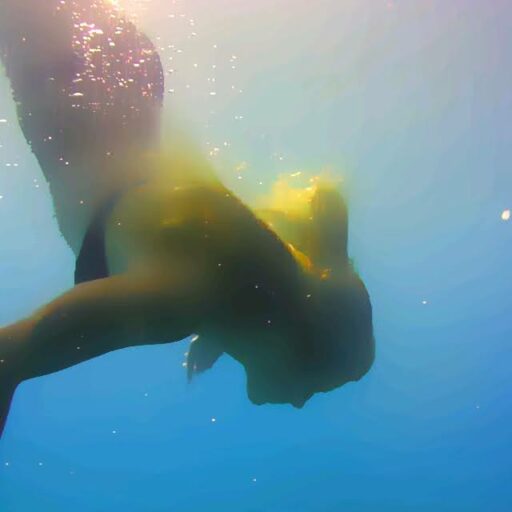Aquawareness is an innovative discipline that transforms swimming into a meditative experience, based on bodily and mental awareness in the aquatic environment. Developed by Giancarlo De Leo, an architect and federal instructor, it combines principles of mindfulness with the liquid environment to create a holistic practice that goes far beyond the technical-sporting aspect.
Fundamental Principles
Mindfulness
It is based on active listening to physical sensations and the aquatic environment through a “floating meditation” that prioritizes initial receptive passivity. This approach is reminiscent of the first sensory experiences in the amniotic fluid.[1]
Dynamic Relationship Between Body and Water
- Use specific positions like the “egg” collection to cancel voluntary propulsion
- Utilize Archimedes’ principle as a tool for psychophysical relaxation
- Transform the pliability of water into opportunities for motor exploration [1][2]
Fasi di apprendimento
- Pure attention: non-judgmental observation of body-water reactions
- Clear Vision: a deliberate choice of conscious movements based on accumulated experience [2]
Comparison with other holistic disciplines
| Disciplina | Ambiente | Struttura | Focus energetico | Obiettivo primario |
|---|---|---|---|---|
| Aquawareness | Acqua | Non strutturata | Consapevolezza | Connessione corpo-mente-acqua, sicurezza, libertà e sopravvivenza in acqua. |
| Ai Chi | Acqua | Sequenze prestabilite | Qi/Chi | Rilassamento e forza |
| Yoga | Terra | Asana precise | Prana/Chakra | Unione corpo-mente-spirito |
| Tai Chi | Terra/Acqua | Forme marziali | Qi/Meridiani | Coordinazione ed energia |
Key Differences:
- Compared to Ai Chi (derived from Tai Chi in water): while Ai Chi uses codified movements to enhance strength and flexibility, Aquawareness focuses on free exploration and sensory perception.[2].
- Concerning Yoga: While both aim for awareness, Yoga focuses on static poses (asanas) and breath control (pranayama) in a terrestrial environment, whereas Aquawareness uses the fluid dynamics for meditation in motion.[3].
- Compared to Tai Chi: while both emphasize the flow of energy, Tai Chi retains martial roots and a choreographed structure, whereas Aquawareness eliminates any predefined patterns in favor of improvisation guided by perception.[2][3].
This discipline stands out for its radically non-performative approach, transforming every aquatic gesture into an opportunity for introspection and reconnection with one’s fluid nature.
Citations:
[1] https://www.fuorimag.it/aquawareness/
[2] https://www.fuorimag.it/aquawareness-bibliografia-ragionata/
[3] https://www.taichichuanroma.com/tai-chi-chuan-e-yoga-principi-simili-per-scopi-diversi/
[4] https://www.tesoridoriente.net/mag/tai-chi-tra-danza-e-poesia
[5] https://www.annagaltarossapsicologa.com/operatore-olistico-chi-e-e-cosa-fa/
[6] https://respiro.yoga/discipline-olistiche-salute/
[7] https://www.marcogamuzza.it/cosa-e-lo-yoga-e-alternative/
[8] https://sindromefibromialgica.it/yoga-e-tai-chi-nuovi-orizzonti-tra-corpo-e-mente/
[9] https://www.fuorimag.it/aquawareness-a-fascinating-concept-that-combines-water-and-mindfulness-to-enhance-both-physical-and-mental-awareness/
[10] https://www.veganok.com/yoga-e-tai-chi-in-acqua/
[11] https://vivere.yoga/scopriamo-i-benefici-del-massaggio-ayurvedico-con-lacqua-della-tradizione-monaci-erranti-2/
[12] https://articoli.nonsolofitness.it/item/2900-principi-e-teoria-del-movimento-in-acqua.html
[13] https://www.gruppo.acea.it/storie/sostenibilita-territorio/obiettivo-6-agenda-2030
[14] http://www.youspa.eu/it/magazine-article/315-awa-la-meditazione-in-acqua-che-cambia-la-vita
[15] https://asvis.it/approfondimenti/22-9349/senza-acqua-non-ce-vita-riflessioni-per-la-giornata-mondiale-dellacqua-2021
[16] http://www.centroalterego.it/terapie-olistiche
[17] https://ilborgozen.it/notizie/benessere/sviluppare-soft-skills-successo-professionale/
[18] https://www.ayurway.it/che-cos-e-un-centro-olistico/
Aquawareness stands out from other holistic disciplines through a revolutionary approach that transforms the aquatic element into a primary tool of awareness, prioritizing free sensory exploration over predetermined structures.
Key Differentiation
1. Environment and Context
- Unique method that utilizes complete immersion in water (especially saltwater) as a meditative catalyst
- Transform water resistance into a therapeutic ally, unlike yoga or tai chi which work against Earth’s gravity
2. Methodological Approach
- Absence of Choreographic Patterns: removes predetermined sequences found in Ai Chi or Water Tai Chi
- Non-performance: focus on perception rather than technical perfection, unlike yoga asanas
- Utilizing imperceptible micro-movements that leverage liquid conductivity
3. Energy Dynamics
- Replaces the concept of chakra/prana with a hydro-sensory flow
- Transform the hydrostatic pressure into a proprioceptive stimulus, unlike Qi Gong which works on the body’s energy field
| Elemento | Aquawareness | Altre discipline |
|---|---|---|
| Movimento | Reattivo/liquido | Programmato/strutturato |
| Respiro | Idro-adattivo | Controllato (pranayama) |
| Interazione | Dialogo corpo-acqua | Lavoro sul corpo |
| Temporizzazione | Cicli mareali | Sequenze cronometriche |
4. Philosophical Aspect
- It brings back the cellular memory of the amniotic environment, unique in the holistic landscape
- Integrate principles of fluid dynamics with mindfulness techniques, an approach absent in terrestrial methods
- Transform water from a passive element to an active co-therapist in practice
This system creates a human-environment symbiosis that cannot be replicated in non-aquatic contexts, making the experience both introspective and physically transformative through the unique properties of the liquid medium.
Tolomeus Arounder

